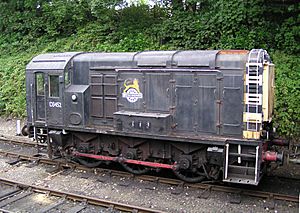British Rail Class 10 facts for kids
Quick facts for kids British Rail Class 10 |
|
 |
|
| D3452, at Bodmin on 28 August 2003. This locomotive is preserved on the Bodmin & Wenford Railway | |
| Power type | Diesel-electric |
|---|---|
| Builder | British Railways Darlington Works and Doncaster Works |
| Build date | 1953–1962 |
| Total production | 161 |
| Configuration | 0-6-0 |
| Gauge | 4 ft 8 1⁄2 in (1,435 mm) |
| Wheel diameter | 4 ft 6 in (1.372 m) |
| Wheelbase | 11 ft 6 in (3.51 m) |
| Length | 29 ft 3 in (8.92 m) |
| Width | 8 ft 6 in (2.59 m) |
| Height | 12 ft 8+1⁄2 in (3.87 m) |
| Locomotive weight | 48.6 long tons (49.4 t) |
| Fuel capacity | 668 imp gal (3,040 L; 802 US gal) |
| Prime mover | Blackstone ER6T |
| Traction motors | D3152–D3166: BTH, 2 off Remainder: GEC nose suspended, 2 off |
| Transmission | DC generator, DC traction motors, double reduction gearing |
| Multiple working | Not fitted |
| Top speed | 27.5 mph (44 km/h) |
| Power output | Engine: 350 hp (261 kW) |
| Tractive effort | Maximum: 35,000 lbf (155.7 kN) Continuous: 11,100 lbf (49.4 kN) |
| Train heating | None |
| Train brakes | Vacuum |
| Career | British Railways |
| Number | 13137–13166; later D3137–D3166, D3439–D3453, D3473–D3502, D3612–D3651, D4049–D4094 |
| Axle load class | RA 5 |
Imagine a powerful little train engine designed to move other train cars around a busy railway yard – that's what a shunter does! The British Rail Class 10 was a special type of diesel locomotive used in Britain. It was quite similar to another popular engine, the Class 08, but it had a different kind of engine inside.
Instead of an engine made by English Electric, the Class 10 used a Blackstone diesel engine. These engines were also "diesel-electric," meaning they used a diesel engine to power a generator, which then made electricity for the motors that turned the wheels. The electric motors, called traction motors, were made by either GEC or BTH companies.
Contents
Building the Class 10 Locomotives
These useful shunting locomotives were built by British Railways at two of their main factories. They were made at the Darlington and Doncaster workshops. Production of these engines took place over several years, starting in 1953 and continuing until 1962.
How Many Were Made?
In total, 161 of these Class 10 locomotives were built. Each one played an important role in moving trains around railway depots and yards across Britain.
Early Names for the Class 10
When these locomotives first came out, they had slightly different names or classifications. The ones that used GEC traction motors were known as Class D3/4. The locomotives that had BTH traction motors were called Class D3/5. Later, they all became part of the Class 10 family.
What Was the Class 10 Used For?
The main job of the Class 10 locomotives was shunting. This means they were used to:
- Move individual train cars or groups of cars.
- Arrange trains in the correct order.
- Take trains to and from loading areas or repair shops.
- Help connect different parts of a train together.
They were like the workhorses of the railway yards, always busy making sure everything was in the right place.
Key Features of the Class 10
The Class 10 locomotives were designed to be strong and reliable for their shunting duties.
Engine Power
The Blackstone engine inside each Class 10 produced about 350 horsepower. This was enough power for moving heavy loads at slow speeds, which is exactly what shunting requires.
Top Speed
Even though they were powerful, these locomotives weren't built for speed. Their top speed was around 27.5 miles per hour (44 km/h). This was perfectly fine for their job of moving trains around yards, where high speeds aren't needed or safe.
Braking System
The Class 10 used a "vacuum brake" system for stopping trains. This was a common type of braking system on British railways at the time.
Images for kids
-
D3452, at Bodmin on 28 August 2003. This locomotive is preserved on the Bodmin & Wenford Railway


